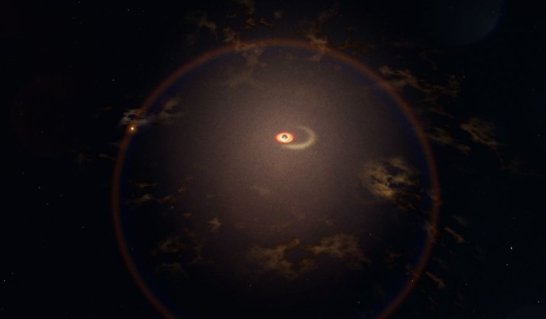‘Old Faithful’ galaxy has brilliant outbursts every 114 days

An “Old Faithful”-like event in space may shed light on the nature of stars near supermassive black holes embedded in galaxies.
Researchers saw repeated outbursts — every 114 days, on average — in a galaxy some 570 million light-years away from Earth. (For perspective, the nearest star system to Earth is roughly 4 light-years away.) The event, known as ASASSN-14ko, is flaring vehemently and in several wavelengths of light.
“These are the most predictable and frequent recurring multiwavelength flares we’ve seen from a galaxy’s core, and they give us a unique opportunity to study this extragalactic Old Faithful in detail. We think a supermassive black hole at the galaxy’s center creates the bursts as it partially consumes an orbiting giant star,” study researcher Anna Payne, a NASA graduate fellow at the University of Hawai’i at Mānoa, stated in a NASA statement.
Payne presented the details Wednesday (Jan. 13) at the virtual 237th meeting of the American Astronomical Society and the results are undergoing scientific review for eventual journal publication.
What astronomers may be witnessing is a “tidal disruption” event, which happens when the huge gravitational force of a black hole rips a nearby star into streams of gas. As the gas falls onto the accretion disk of the black hole, flare-ups occur that can be seen hundreds of millions of light-years away.
“The astronomers suggest that one of the galaxy’s supermassive black holes, one with about 78 million times the sun’s mass, partially disrupts an orbiting giant star,” NASA said in the statement. “The star’s orbit isn’t circular, and each time it passes closest to the black hole, it bulges outward, shedding mass but not completely breaking apart. Every encounter strips away an amount of gas equal to about three times the mass of Jupiter.”
The study team used NASA’s Neil Gehrels Swift Observatory, the planet-hunting NASA Transiting Exoplanet Survey Satellite (TESS), NASA’s Nuclear Spectroscopic Telescope Array (NuSTAR) and the European Space Agency’s XMM-Newton X-ray telescope to observe recent flares, to name a few participating observatories.
All told, Payne’s team gathered data on 20 flares. The event takes place in the galaxy ESO 253-3; since it repeats, the flaring is of special interest to astronomers to help them identify the cause of these events and to look for novel information.
ESO 253-3 is called an “active galaxy,” meaning that it has a very bright center that varies in luminosity. Active galaxy emissions are thought to arise near the supermassive black hole at a galaxy’s center, after gas and dust in the region builds up. As the black hole “eats” the material, the activity creates random changes in brightness in the galactic disk’s light.
Researchers first spotted ASASSN-14ko on Nov. 14, 2014 using a global network of 20 robotic telescopes called the All-Sky Automated Survey for Supernovae (ASAS-SN), headquartered at Ohio State University. At first, astronomers thought the flare came from a supernova — a one-time star explosion. But Payne noticed a regular pattern of flares while studying data from ASASSN-14ko in 2020, as part of her thesis work.
Armed with the data, Payne’s team looked at the ESO 253-3 galaxy again on May 17, 2020 — the next predicted date for a flare-up — using several ground- and space-based facilities. They caught the flare exactly when they had predicted it would occur, then also predicted and observed subsequent flares on Sept. 7 and Dec. 20.
In terms of the NASA telescopes, Swift allowed the team to observe the flare in multiple wavelengths of light, while the all-sky capabilities of TESS let the team chart a timeline of flare activity during such an event in 2018, from emergence to peak brightness to decline.
While the supermassive black hole hypothesis is the leading theory for the flare, Payne’s team has others they are investigating. The other theories suggest that perhaps two orbiting supermassive black holes are interacting and flaring (although the black holes in the galaxy are likely too far apart to cause this), or a star passing on an inclined orbit through the disk of the black hole (which is unlikely as the flares are symmetrical, not lopsided as such an orbit would produce).
Payne’s team is continuing to study events in 2021, although NASA warned the flares could cease at any time. “The star can’t lose mass forever, and while scientists can estimate the amount of mass it loses during each orbit, they don’t know how much it had before the disruptions began,” the agency said.



 Creators of mankind
Creators of mankind Description of “Tall white aliens”
Description of “Tall white aliens” Where they came from?
Where they came from? About hostile civilizations
About hostile civilizations The war for the Earth
The war for the Earth “Tall white aliens” about eternal life
“Tall white aliens” about eternal life Video: “Nordic aliens”
Video: “Nordic aliens” Aliens
Aliens Alien encounters
Alien encounters The aliens base
The aliens base UFO
UFO Technology UFO
Technology UFO Underground civilization
Underground civilization Ancient alien artifacts
Ancient alien artifacts Military and UFO
Military and UFO Mysteries and hypotheses
Mysteries and hypotheses Scientific facts
Scientific facts


















